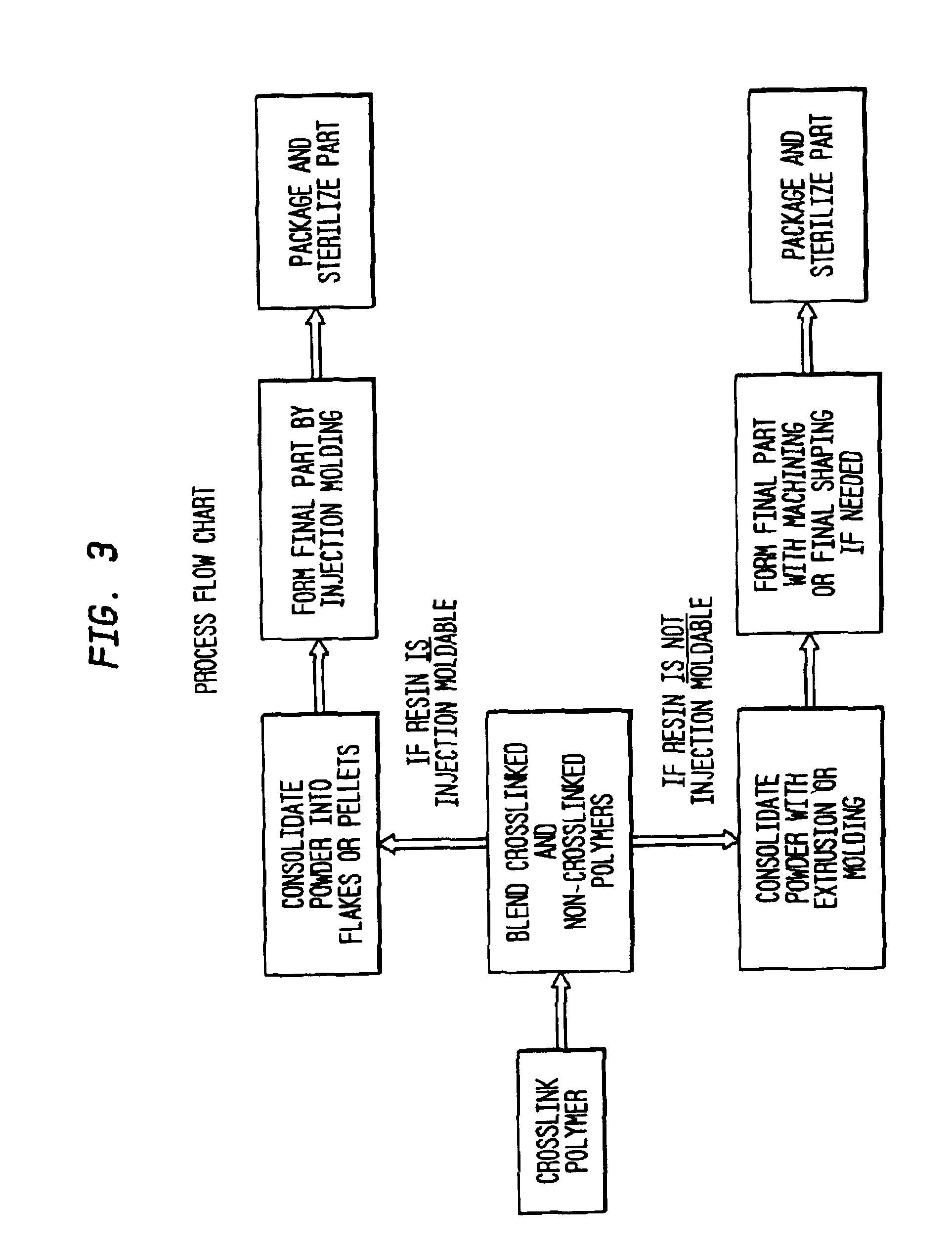Methods of improving the wear resistance of prosthetic medical devices
a prosthetic medical device and wear resistance technology, applied in the field of polymer, can solve the problems of reducing the wear resistance of prosthetic medical devices, so as to reduce the level of polymeric material released from the device, avoid the effect of reducing the level of polymeric material
- Summary
- Abstract
- Description
- Claims
- Application Information
AI Technical Summary
Benefits of technology
Problems solved by technology
Method used
Image
Examples
example i
[0035]GUR1050 (e.g., UHMWPE having average molecular weight of 4,000,000-6,000,000) powder was irradiated at 12 Mrads in a nitrogen atmosphere and stabilized in a nitrogen atmosphere at 100° C. for three days. Several mixtures of the cross-linked irradiated powder were prepared by blend-mixing with non-irradiated powder in the following proportions
[0036]
SAMPLE% IRRADIATED,% NON-NUMBERCROSSLINKEDIRRADIATED1 5952 10%90%3 30%70%4100% 0%
[0037]A reference sample (Sample 0) containing 0% irradiated and 100% un-irradiated powder was also prepared.
[0038]The powder samples were compression molded into blanks which were machined into cups and then subjected to a hip simulator test to determine the wear rate of the material.
[0039]The results were as follows:
[0040]
WEAR RATE% REDUCTIONSAMPLE(mm3 / 106(fromNUMBERcycles)reference)% CROSSLINKED0 (Reference)102.100123.177.45210.689.61035.894.33041.998.1100
[0041]The results show that a mixture containing as little as 5% irradiated material produces an ...
example ii
[0042]GUR1050 (e.g., UHMWPE having average molecular weight of 4,000,000-6,000,000) powder was irradiated at 12 Mrads in a nitrogen atmosphere and stabilized in a nitrogen atmosphere at 100° C. for three days. A mixture of the cross-linked irradiated powder was prepared by blend-mixing with HDPE non-irradiated powder in the following proportions:
[0043]
SAMPLE% IRRADIATED,% NON-NUMBERCROSSLINKEDIRRADIATED10100 (UHMWPE)230 (UHMWPE)70 (HDPE)
[0044]A reference sample (Sample 1) containing 0% irradiated and 100% non-irradiated powder was also prepared.
[0045]The powder samples were injection molded into blanks which were machined into cups and then subjected to a hip simulator test to determine the wear rate of the material.
[0046]The results were as follows:
PUM
| Property | Measurement | Unit |
|---|---|---|
| temperature | aaaaa | aaaaa |
| temperature | aaaaa | aaaaa |
| temperature | aaaaa | aaaaa |
Abstract
Description
Claims
Application Information
 Login to View More
Login to View More - R&D
- Intellectual Property
- Life Sciences
- Materials
- Tech Scout
- Unparalleled Data Quality
- Higher Quality Content
- 60% Fewer Hallucinations
Browse by: Latest US Patents, China's latest patents, Technical Efficacy Thesaurus, Application Domain, Technology Topic, Popular Technical Reports.
© 2025 PatSnap. All rights reserved.Legal|Privacy policy|Modern Slavery Act Transparency Statement|Sitemap|About US| Contact US: help@patsnap.com


